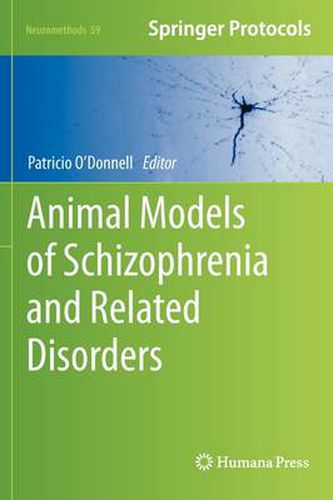Readings Newsletter
Become a Readings Member to make your shopping experience even easier.
Sign in or sign up for free!
You’re not far away from qualifying for FREE standard shipping within Australia
You’ve qualified for FREE standard shipping within Australia
The cart is loading…






This title is printed to order. This book may have been self-published. If so, we cannot guarantee the quality of the content. In the main most books will have gone through the editing process however some may not. We therefore suggest that you be aware of this before ordering this book. If in doubt check either the author or publisher’s details as we are unable to accept any returns unless they are faulty. Please contact us if you have any questions.
Animal models of schizophrenia and other major psychiatric disorders have been sought for decades, and, as a result, we are now facing new vistas on pathophysiology that could lead to novel therapeutic approaches and even hint at possible preventive strategies. Animal Models of Schizophrenia and Related Disorders presents an overview of the information that can be obtained with several different models and a detailed account of how to generate such models in order to ensure that the manipulations used to model schizophrenia-relevant phenomena are used consistently across laboratories. This detailed volume features pharmacological models such as non-competing NMDA antagonists, emphasizing their use in vitro, neurodevelopmental models such as the neonatal ventral hippocampal lesion and the antimitotic MAM, models that reproduce environmental factors such as neonatal hypoxia, vitamin D deficits, and prenatal immune activation, as well as several different genetic model approaches. As a volume in the Neuromethods series, this volume contains the kind of detailed description and implementation advice that is crucial for getting optimal results.
Practical and cutting-edge, Animal Models of Schizophrenia and Related Disorders highlights the successes in the use of animal models to gain insight on pathophysiological mechanisms of relevance to major psychiatric disorders in the hope of inspiring investigators to expand the research and test targets that could restore or ameliorate function.
$9.00 standard shipping within Australia
FREE standard shipping within Australia for orders over $100.00
Express & International shipping calculated at checkout
This title is printed to order. This book may have been self-published. If so, we cannot guarantee the quality of the content. In the main most books will have gone through the editing process however some may not. We therefore suggest that you be aware of this before ordering this book. If in doubt check either the author or publisher’s details as we are unable to accept any returns unless they are faulty. Please contact us if you have any questions.
Animal models of schizophrenia and other major psychiatric disorders have been sought for decades, and, as a result, we are now facing new vistas on pathophysiology that could lead to novel therapeutic approaches and even hint at possible preventive strategies. Animal Models of Schizophrenia and Related Disorders presents an overview of the information that can be obtained with several different models and a detailed account of how to generate such models in order to ensure that the manipulations used to model schizophrenia-relevant phenomena are used consistently across laboratories. This detailed volume features pharmacological models such as non-competing NMDA antagonists, emphasizing their use in vitro, neurodevelopmental models such as the neonatal ventral hippocampal lesion and the antimitotic MAM, models that reproduce environmental factors such as neonatal hypoxia, vitamin D deficits, and prenatal immune activation, as well as several different genetic model approaches. As a volume in the Neuromethods series, this volume contains the kind of detailed description and implementation advice that is crucial for getting optimal results.
Practical and cutting-edge, Animal Models of Schizophrenia and Related Disorders highlights the successes in the use of animal models to gain insight on pathophysiological mechanisms of relevance to major psychiatric disorders in the hope of inspiring investigators to expand the research and test targets that could restore or ameliorate function.